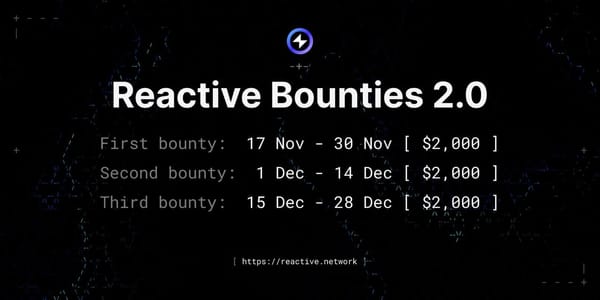Understanding Reactive Smart Contracts (RSC): Revolutionizing On-Chain Operations
In an era where smart contracts are reshaping the world of decentralized finance (DeFi), a new concept has emerged: Reactive Smart…

In an era where smart contracts are reshaping the world of decentralized finance (DeFi), a new concept has emerged: Reactive Smart Contracts (RSC).
This innovative approach promises to transform how decentralized applications (dApps) operate, making them more efficient, flexible, and interconnected.
What Are Reactive Smart Contracts (RSC)?
Building upon existing blockchain tools like Gelato and Uniswapv4 Hooks, which have introduced on-chain IFTTT (If This Then That) capabilities, Reactive Smart Contracts aim to standardize and embed this functionality directly into blockchains. Unlike traditional smart contracts, RSCs can:
- Accumulate state within the blockchain, immediately accessible to other smart contracts without needing custom oracles.
- Process historical blockchain data, making it almost indistinguishable from current operations.
- Construct supporting information for events like airdrops, perform on-chain actions, and make real-time on-chain decisions.
How Does It Work?
By modifying the Ethereum Virtual Machine (EVM) and extending the Solidity language, developers have given RSCs the ability to interact seamlessly with other smart contracts in the same environment. This enables Reactive Smart Contracts to provide a more generalized approach, offering functionalities like Gelato or Clockwork directly within the writing process of a smart contract. This, in turn, allows any smart contract to harness the power of on-chain hooks.
The deterministic nature of blockchains further ensures that RSCs can transparently and trustlessly combine information from multiple blockchains. It’s an approach that simplifies inter-blockchain compatibility and integration, empowering dApps to pull in data, react to new blocks on different chains, all at once.
Reactive EVM and The Future of Smart Contracts
Envisioned as a blend of L1 and L0 architectures, the platform will enable the deployment of Reactive Smart Contracts. It will connect with other EVM chains via a Relayer Network, facilitating actions across various chains. This means events monitored on one chain can trigger transactions on another.
Moreover, developers anticipate the introduction of some of these advancements to the Ethereum Foundation via Ethereum Improvement Proposals (EIP), enhancing the Ethereum ecosystem’s overall capabilities.
Use Cases for RSC
The applications for Reactive Smart Contracts are vast. They can automate liquidity management, manage collateralized positions, and even automatically detect and purchase newly deployed coins. Established platforms like DEXes, PERPs platforms, and lending protocols can significantly expand their functionality. For instance:
- DEXes could enable users to arbitrage cross-chain.
- Aave could let users auto-add/remove collateral based on specific triggers.
- PERPs platforms might incorporate intricate conditional logic for order executions.
Additionally, RSCs could support entirely new applications like treasury management for DAOs, cross-chain liquidity platforms, and AI/ML models.
Reactive Smart Contracts & EVM
Traditionally, the EVM architecture hindered the development of such innovations. Issues like gas concerns and the inability of smart contracts to pay for their gas have been roadblocks. However, these challenges have now been addressed by modifying the EVM and enhancing Solidity, allowing smart contracts to pay their gas and using parallel transaction processing to empower RSCs.
Integration with DeFi
Beyond the obvious applications, RSCs offer a toolset for creating a more mature DeFi. They can allow:
- Lending protocols to auto-manage risk and collateralization.
- Liquidity pools to reactively focus liquidity based on market volatility.
- Creation of new derivative types based on on-chain indicators.
All of these possibilities could make DeFi more appealing to regulators, fostering more widespread adoption.
In Conclusion
As the DeFi space evolves, tools like Reactive Smart Contracts are not just innovations but necessities. They represent the next step in making decentralized applications more efficient, more interconnected, and, most importantly, truly smart.





